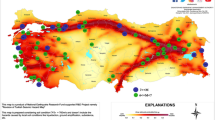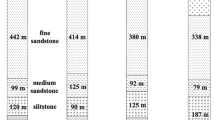Abstract
Strain analysis is frequently used by disciplines such as material, tensile strength, mechanics, and soil mechanics. Strain causes deformation based on normal, shear, and torsional strain types. Strain cannot be measured directly, but it can be calculate by measuring deformation. Many plates are present on Earth. These plates move with respect to each other. One of the research fields of geodynamics is determining the plate movement properties. These properties are amount of plate movement with respect to other plates, rotation of plates, and the strain at plate borders and within plates. These plate movements can be calculated with seismic or geological data and geodetic data. In this study, strain analysis was conducted upon the results obtained from 35 GPS locations on Kelkit valley, which is on the Northern Anatolian fault zone (NAFZ), between the years of 2006 and 2008. Additionally, meaningful strain accumulation was found in the zones that were investigated, and its correspondence with the tectonic structure of the region was confirmed. The maximum and minimum principle strain rate parameters and maximum principle strain rate direction, which provides the average strain rate and strain directions, are E1 = 0.17 μs/year, E2 = −0.24 μs/year, and β = −14.33 °. Furthermore, the mean pure shear strain rate of the region and the engineering shear strain rate was calculated as γ 1 = −0.21 μrad/year, and γ 2 = 0.19 μrad/year, respectively. According to these results, there is a strain accumulation in this region.







Similar content being viewed by others
References
Ambraseys N (1970) Some characteristic features of the Anatolian fault zone. Tectonophysics 9:143–165
Ayhan ME, Demir C, Lenk O, Kiliçoğlu A, ALTINER Y, Barka A, Ergintav S, Özener H (2002) Interseismic strain accumulation in the Marmara Sea Region. Bull Seismol Soc Am 92(1):216–229
Barka A, GIILEN L (1989) Complex evolution of the Erzincan Basin (eastern Turkey). J Struct Geol 11:275–283
Baysal D, AKTUĞ B, Koçyiğit A (2010) Analysis and interpretation of temporal change of GPS coordinates: a case study in Izmir Region. Harita Derg 144:29–39 (in Turkish)
Chen R (1991) On horizontal crustal deformation in Finland. Rep Finn Geod Inst 91:1, Helsinki
Craymer MR, Vanicek P (1989) Netan—a computer program for the interactive analysis of geodetic networks. CISM J ACSGC 43(1):25–37
Demir C (1999) The western part of the North Anatolian fault zone horizontal movement and strain accumulation investigation of earth crust. YTÜ, Institute of Science, PhD Thesis, Istanbul
Deniz R (1990) Determination of the Earth's crust to measure the strain of local geodetic. ITÜ Derg 48:4 (in Turkish)
Deniz I, Özener H (2008) Determination of velocity field and strain accumulation of densification network in Marmara Region. FIG Working Week 2008, Stockholm, pp 14–19
Denli HH (1998) Determination of crustal movements analysis in the Marmara Sea Region using GPS. PhD dissertation, Istanbul Technical University, Istanbul (in Turkish)
Doğan U (2002) Research on kinematic models of deformation from 17 August 1999 Izmit earthquake. YTÜ, Institute of Science, PhD Thesis, Istanbul
Feigle KL, King RW, Jordan TH (1990) Geodetic measurements of tectonic deformation in the Santa Maria Fold and trust belt, California. J Geophys Res 95(B3):2679–2699
Fotiou E, Liveratos E (1983) A strain interpretation in the comparison of network coordinate differences due to datum change. Bull Géod 58(4):527–540
Fuenzalida H, Dorbath L, Cisternas A, Eyidogan H, Barka A, Rivera L, Haessler H, Philip H, Lyberis N (1997) Mechanism of the 1992 Erzincan earthquake and its aftershocks, tectonics of the Erzincan Basin and decoupling on the North Anatolian fault. Geophys J Int 129(1):1–28
Harvey BR (1990) Practical least squares and statistics for surveyors, school of surveying. University of New South Wales, Australia
Hempton M, Dunne L (1984) Sedimentation in pull-apart basins: active examples in eastern Turkey. J Geol 92:513–530
Herring TA, King RW, Mcclusky S (2006a) Documentation for the GAMIT GPS analysis software. Massachusetts Institute of Technology, ABD, Cambridge
Herring TA, King RW, Mcclusky S (2006b) Documentation for the GLOBK GPS analysis software. Massachusetts Institute of Technology, ABD, Cambridge
Kahle HG, Cocard M, Peter Y, Geiger A, Reilinger R, Mcclusky S, King R, Barka A, Veis G (1999) The GPS strain rate field in the Aegean Sea and western Anatolia. Geophys Res Lett 26(16):2513–2516
Kakkuri J (1997) Postglacial deformation of the Fennoscandian crust. Geophysica 33(1):99–109
Kaypak B, Eyidoğan H (2002) Erzincan basin and the upper-crust velocity structure is due to (1-B) to determine. ITÜ Derg Mühendislik Cilt 1(Sayi:2):107–122
Ketin I (1976) A comparison between the San Andreas and the North Anatolian faults. Geol Soc Turk Bull 19:149–154
Koçyiğit et al. (2005) Seismicity of the zone between İsmetpasa-Gerede and Mengen of North Anatolian Fault Zone (NAFZ), The Scientific and Technical Research Council of Turkey Project Number: 102Y053, Turkey
Mcclusky S, Balassanian S, Barka A, Demir C, Ergintav S, Georgiev I, Gurkan O, Hamburger M, Hurst K, Kahle H, Kastens K, Kekelidze G, King R, Kotzev V, Lenk O, Mahmoud S, Mishin A, Nadariya M, Ouzounis A, Paradissis D, Peter Y, Prilepin M, Reilinger R, Sanli I, Seeger H, Tealeb A, Toksoz MN, Veis G (2000) Global positioning system constraints on plate kinematics and dynamics in the eastern Mediterranean and Caucasus. J Geophys Res 105:5695–5719
Mierlo J (1981) Some aspect of strain analysis by geodetic methods, forty years of thought, II:507–526
Özener H, Doğru A, Unlutepe A (2009) An approach for rapid assessment of seismic hazards in Turkey by continuous GPS data. Sensors 9(1):602–615
Özener H, Arpat E, Ergintav S, Dogru A, Cakmak R, Turgut B, Doğan U (2010) Kinematics of the eastern part of the North Anatolian fault zone. J Geodyn 49:141–150
Philip H, Cisternas A, Gvishiani A, Gorshkov A (1989) The Caucasus: an actual example of the initial stages of continental collision. Tectonophysics 161:1–21
Reilinger R, Mcclusky S, Vernant P, Lawrence S, Ergintav S, Cakmak R, Ozener H, Kadirov F, Guliev I, Stepanyan R, Nadariya M, Galaktion H, Mahmoud S, Sakr K, Arrajehi A, Paradissis D, AL-AydruS A, Prilepin M, Guseva T, Emre E, Evren, Dmitrotsa A, Filikov SV, Gomez F, AL-Ghazzi R, Karam G (2006) GPS constraints on continental deformation in the Africa–Arabia–Eurasia continental collision zone and implications for the dynamics of plate interactions. J Geophys Res 111:B05411. doi:10.1029/2005JB004051
Şaroğlu F, Emre Ö, Kuşçu I (1992) Active fault map of Turkey. General Directorate of Mineral Research and Exploration, Ankara
Schneider D, Vanicek P (1991) A new look at the U.S geological survey 1970–1980 horizontal crustal deformation data around Hollister, California. J Geophys Res 96(B13):21641–21657
Şengör AMC, Tüysüz O, Imren C, Sakinç M, Eyidoğan H, Görür N, Le Pichon X, Rangin CC (2005) The North Anatolian fault: a new look. Annu Rev Earth Planet Sci 33:1–75
Tatar O (1996) Determination of extension direction in naturally deformed limestones within strike-slip fault zones using microcracks; Niksar basin (Turkey) as a case study. Turk J Earth Sci 5:45–53
Tatar O, Temiz H, Tutkun SZ, Stimpson I, Park RG (1993) Tectonic setting and surface breaks of the 13–15 March 1992 Erzincan earthquake. Geol J 28:327–333
Tatar O, Gürsoy H, Koçbulut F, Kavak KŞ, Sezen TF, Polat A, Akpinar Z, Mesci L, Kiratik LO (2006) North Anatolian fault zone—1942 Erbaa-Niksar earthquake surface ruptures: new observations, ATAG10, 2–4 Kasim
Tatar O, Poyraz F, Gürsoy H, Çakir Z, Ergintav S, Akpinar Z, Koçbulut F, Sezen F, Türk T, Hastaoğlu ÖK, Polat A, Mesci BL, Gürsoy Ö, Ayazli IE, Çakmak R, Belgen A, Yavaşoğlu H (2012) Crustal deformation and kinematics of the Eastern Part of the North Anatolian fault zone (Turkey) from GPS measurements. Tectonophysics 518:55–62. doi:10.1016/j.tecto.2011.11.010
Vanicek P, Thapa K, Ve Schneider D (1981) The use of strain to identify incompatible observations and constraints in horizontal geodetic networks. Manuscr Geodaet 6:257–281
Wells DE, Krakiwsky EJ (1971) The method of least squares. Department of Surveying Engineering, University of New Brunswick Fredericton N.B, Lecture Notes No. 18, Canada
Welsch W (1981) Description of homogeneous horizontal strains and some remarks, IAG Sym. On geodetic networks and computation, DGK, Reihe B, H. 258/V, 188–205
Wessel P, Smith WHF (2001) The generic mapping tools (GMT) version 3.4 technical reference & cookbook. SOEST/NOAA
Wu J, Tang C, Chen Q (2003) First order optimization for GPS crustal deformation monitoring networks. Proceedings of the 7th South East Asian Surveying Congress, Hong Kong
Yavaşoğlu H, Tari E, Tüysüz O, Çakir Z, Ergintav S (2011) Determining and modeling tectonic movements along the central part of the North Anatolian Fault (Turkey) using geodetic measurements. J Geodyn 51:339–343
Acknowledgments
The GNSS data used in this study were obtained from the DPT 2006 K 120220 numbered project. In the evaluation of the GNSS data, GAMIT/GLOBK software developed by Massachusetts Institute of Technology (MIT) was used. Also, for map drawings, GMT (Wessel and Smith 2001) software was utilized. The author would like to thank the reviewers for their valuable comments that helped to improve the paper.
Author information
Authors and Affiliations
Corresponding author
Rights and permissions
About this article
Cite this article
Poyraz, F. Determining the strain upon the eastern section of the North Anatolian fault zone (NAFZ). Arab J Geosci 8, 1787–1799 (2015). https://doi.org/10.1007/s12517-014-1301-6
Received:
Accepted:
Published:
Issue Date:
DOI: https://doi.org/10.1007/s12517-014-1301-6




